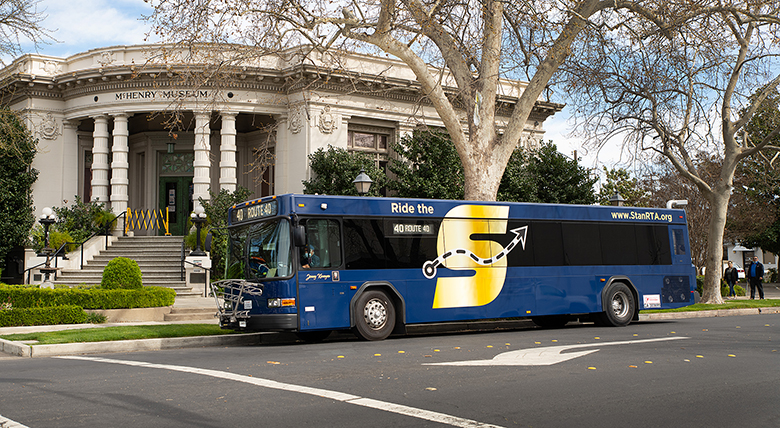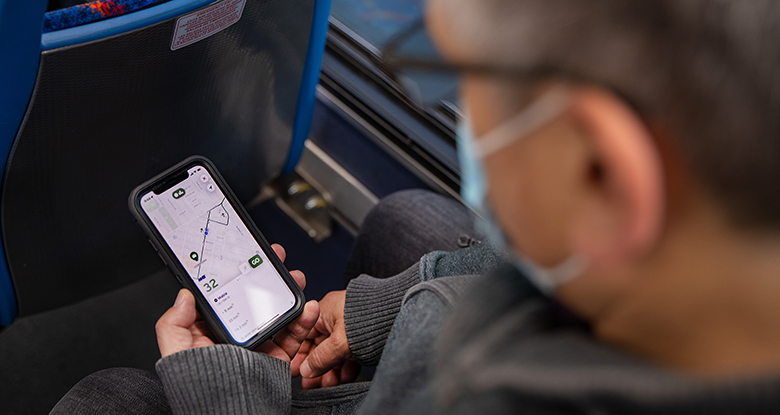
The Stanislaus Regional Transit Authority (StanRTA) was formed in 2021 to consolidate two transit systems that operated in Stanislaus County – Modesto Area Express (MAX) and Stanislaus Regional Transit (StaRT). Today, the consolidated StanRTA operates a fleet of 130 vehicles providing 2.3 million trips annually.
Serving primarily California’s Stanislaus County, including the city of Modesto and its surrounding rural areas, the agency has required oversight and innovation from its Intelligent Transportation Systems (ITS) since its inception. Dating back to 2006, the MAX system utilized the myAvail Enterprise Transit Management Software (ETMS) by Avail Technologies. Adam Barth joined MAX as a transit manager when the city began implementing myAvail’s rider-facing mobile app and was key in that implementation process.
Since the merger that formed StanRTA, he moved into the role of Director of Operations and Planning, before becoming the StanRTA CEO in 2021.
“One of my key philosophies, dating back to when I arrived and helped implement the mobile app, was that you have to make transit easy to use,” Barth said. “I pushed for us to use the Avail system to its fullest potential, including getting information to the riders. It took some upgrades to equipment and our training, but today the public and our riders are reliant on this information being at their fingertips.”

When the consolidation happened in 2021, Barth said the two agencies were using systems from two different providers. After a review process of both systems, StanRTA chose to continue utilizing myAvail for its CAD/AVL, routing, rider information, and enterprise level transit management.
“And so, we installed the Avail equipment on the county’s buses that came over as part of the consolidation,” he said. “So now, no matter what bus you’re on in the county or in any of the cities, riders are using the same app – making it that much easier to ride.”
“Recognizing their investment and knowing how to get the most out of it is probably one of the biggest things we’ve seen in Modesto,” said David Mugica, Director of Business Development at Avail Technologies. “Then secondly, they’re always looking to do something new. They don’t rest on their laurels.
Transit Management at the Enterprise Level
In addition to utilizing the myStop app (rebranded for StanRTA as “Track the S”) for riders, StanRTA has integrated the app with its fare collection by Token Transit. In this way, riders can access vehicle and route information as well as purchase passes from a single app.
“Riders can check the app to see if their bus is late, how many people are on board, and whether its route will be affected by detours,” Barth said. “Riders can set alerts if their bus is going to be late, and we can also put our announcements – like free fare days – directly into the app for our customers.”
Barth said that, in the event of a detour, StanRTA can change the route display in real-time – allowing for riders to see the exact path of their re-routed bus, as well as the stops they will miss due to detour. “These apps make riding the bus easier, and that is one of the keys to a successful transit system.”
“The CAD/AVL system, in terms of locating buses and having an app, is not exactly unique in transit,” Mugica said. “What makes us different is how we make those changes in our system. Whether it’s canceling the vehicle, adding detours, or adding another vehicle into service – any change we make in our system gets pushed through immediately.”
“Look at this more as paperless operation,” he continued. “When we make changes in our system, not only are drivers, dispatchers, customer service, and passengers notified, but any downstream piece of equipment—whether it’s signage, websites, apps, social media, whatever the new TikTok is—we push it all out with one click of the button, and it doesn’t require any third parties to intervene.”

On the backend, the ETMS provides StanRTA with a single database for data to flow seamlessly throughout the agency. Business intelligence dashboards report real-time metrics to improve efficiency, justify funding requests, and demonstrate compliance. Dispatchers know the locations of every bus and driver, incidents are tracked as they occur, and vehicle health monitoring predicts failures so maintenance can ensure buses hit the road as scheduled.
“The biggest goal for an agency like StanRTA is, first, improving on-time performance,” said Vic Kumar, Senior Systems Engineer for Avail Technologies. “With all the technology they have now, along with the data they are collecting in real-time, significantly improving on-time performance is much easier to achieve.”
“The other major benefit is National Transit Database (NTD) reporting,” Kumar continued. “For NTD certification, StanRTA needs accurate passenger counting. We have installed automated passenger counters (APC) on every vehicle and validate the passenger count data against the revenue collected that. That all leads to more funding, which is a key benefit.”
The next major technology implementation on StanRTA’s agenda is the introduction of Avail’s voice-over IP (VoIP) to replace the agency’s radio system. The agency will switch out its leased data radios in favor of a 100 percent cellular service, on a state plan which costs the agency nothing.
“In addition to the huge savings, the current radio systems encounter a lot of ‘dead zones,’” Kumar said. “We’ve tested the VoIP’s coverage and those dead zones will now be negated.”
Technology Implementation
In an installation or upgrade of this magnitude, Avail first conducts a survey of all the vehicles that will require new hardware. The CAD/AVL group then creates a bill of materials for each vehicle type, in a process that takes anywhere from two to four weeks.
From there, Avail’s production team begins ordering components and building vehicle kits, before sending the kits to StanRTA’s facilities. Third-party installers and Avail’s field engineers arrive to support the installation effort, and Avail conducts on-site training while aiding with the initial vehicle pilots.
Once the process is complete, the agency and Avail conduct a full-fleet rollout. In the case of a large agency like StanRTA, this rollout can take up to two months to complete.
“We’ve also done different refresher trainings over the years, where Avail has come out, sat in dispatch, and worked with dispatchers in a live setting,” Barth said. “It’s not just a classroom with a PowerPoint – they’re there in a live situation, helping the dispatchers improve their skills as they use the system.”

Ensuring a Successful Path Forward
Mugica said that StanRTA has been just as active on successful technology implementation as the Avail team, by holding Avail accountable for completing the job correctly.
“StanRTA is very informed and educated,” he said. “They do their due diligence to see what’s happening in the market – not just other companies, but within Avail as well. They know what’s happening in the industry and are keen to make sure we address their needs.”
Barth said StanRTA drivers are aware of the system’s critical value for tracking miles and hours, and for passenger information. It ultimately makes their jobs easier, he said, when customers are more informed about their trip prior to embarking.
As an example of the system’s importance, Barth highlighted a major route change that occurred in March, wherein multiple routes between Modesto and the larger county shifted. With such a major change to the agency’s services, it was vital for StanRTA to inform its riders ahead of time.
“You need the riders to know about it,” he said. “We added announcements about the upcoming change to all of our vehicles, reading out at intersections and bus stops. We had social media posts promoting the change. And, importantly, we pushed alerts about the route change to all our riders on the app. The system allowed us to do everything we could to broadcast the information to our riders.”
“StanRTA, when they purchase something, is very good at making sure they have proper adoption,” Mugica said. “That’s key in any industry, not just transit. They go above and beyond by having a healthy knowledge base as well as champions of the technology within the agency.”
